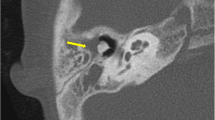Abstract
Cholesteatoma is a common disease of the middle ear cleft associated with several complications, Surgery is the mainstay for the management of such a pathological condition, however, complications may occur including intracranial ones due to violation of middle cranial fossa dura. Anatomical variations have been reported and High-resolution CT scan is the major tool for detecting such variations. In this study, we aim to determine if there is a difference between tegmen height between both sides of patients with unilateral cholesteatoma. 21 patients were recruited for such study all underwent HRCT and the tegmen height was determined in two coronal planes, the first between the central point of the Henle spine and the tegmen, the other between the plane of both lateral canals and the roof of the middle ear. The tegmen height measurements showed that the affected side had significantly lower tegmen height Henle spine (6.30 ± 1.54 vs. 9.03 ± 1.34 (mm); p < 0.001) relative to the healthy side. Also, coronal plane measurement has shown statistical significance for tegmen height (2.98 ± 0.79 vs. 4.15 ± 0.76 (mm); p = 0.01) in comparison to the healthy side. The percentage of difference between both sides as regards tegmen height of Henle’s spine and coronal measurement was 30.32% and 28.2%, respectively. A significant difference was found in tegmen height between healthy and diseased sides in patients with unilateral cholesteatoma.
















Similar content being viewed by others
References
Olszewska E et al (2004) Etiopathogenesis of cholesteatoma. Eur Arch Otorhinolaryngol 261(1):6–24
Michaels L (1987) Ear, nose and throat histopathology. Springer, London. https://doi.org/10.1007/978-1-4471-3332-2
Wright CG, Robinson KS, Meyerhoff WL (1996) External and middle ear pathology in TGF-alpha-deficient animals. Am J Otol 17(2):360–365
Yates PD et al (2002) CT scanning of middle ear cholesteatoma: what does the surgeon want to know? Br J Radiol 75(898):847–852
Makki FM et al (2011) Anatomic analysis of the mastoid tegmen: slopes and tegmen shape variances. Otol Neurotol 32(4):581–588
Marchioni D et al (2014) Combined approach for tegmen defects repair in patients with cerebrospinal fluid otorrhea or herniations: our experience. J Neurol Surg B Skull Base 75(4):279–287
Karatag O et al (2014) Tegmen height: preoperative value of CT on preventing dural complications in chronic otitis media surgery. Clin Imaging 38(3):246–248
Husain M et al (2020) Role of HRCT temporal bone in pre-operative assessment of tegmen height in chronic otitis media patients. J Clin Imaging Sci 10:79
Abdulmonaem G et al (2015) The role of HRCT in evaluation of aquaired middle ear cholesteatoma OTITIS prior surgery. Zagazig Univ Med J 21(5):1–13
Mafee MF et al (1988) Cholesteatoma of the middle ear and mastoid. A comparison of CT scan and operative findings. Otolaryngol Clin North Am 21(2):265–293
Aberg B et al (1991) Clinical characteristics of cholesteatoma. Am J Otolaryngol 12(5):254–258
Gomaa MA et al (2013) Evaluation of temporal bone cholesteatoma and the correlation between high resolution computed tomography and surgical finding. Clin Med Insights Ear Nose Throat 6:21–28
Genc S et al (2014) Location of the middle cranial fossa dural plate in patients with chronic otitis media. J Laryngol Otol 128(1):60–63
Funding
Our study did not receive any funding support.
Author information
Authors and Affiliations
Corresponding author
Ethics declarations
Conflict of interest
No conflict of interest for such study.
Additional information
Publisher's Note
Springer Nature remains neutral with regard to jurisdictional claims in published maps and institutional affiliations.
Rights and permissions
Springer Nature or its licensor (e.g. a society or other partner) holds exclusive rights to this article under a publishing agreement with the author(s) or other rightsholder(s); author self-archiving of the accepted manuscript version of this article is solely governed by the terms of such publishing agreement and applicable law.
About this article
Cite this article
Alhussaini, M.A., Zaka, M.Z., Moubark, M. et al. Radiological Evaluation of Middle Cranial Fossa Dura in Patients with Unilateral Cholesteatoma. Indian J Otolaryngol Head Neck Surg (2024). https://doi.org/10.1007/s12070-024-04699-4
Received:
Accepted:
Published:
DOI: https://doi.org/10.1007/s12070-024-04699-4




